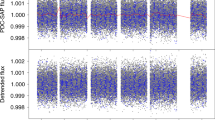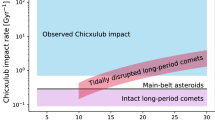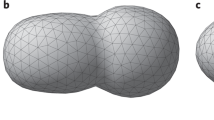Abstract
The first discovered interstellar object (ISO), ‘Oumuamua (1I/2017 U1) shows a dry and rocky surface, an unusually elongated shape, with short-to-long axis ratio c∕a ≲ 1∕6, a low velocity relative to the local standard of rest (~10 km s−1), non-gravitational accelerations and tumbles on a timescale of a few hours1,2,3,4,5,6,7,8,9. The inferred number density (~3.5 × 1013−2 × 1015 pc−3) for a population of asteroidal ISOs10,11 outnumbers cometary ISOs12 by ≥103, in contrast to the much lower ratio (≲10−2) of rocky/icy Kuiper belt objects13. Although some scenarios can cause the ejection of asteroidal ISOs14,15, a unified formation theory has yet to comprehensively link all ‘Oumuamua’s puzzling characteristics and to account for the population. Here we show by numerical simulations that ‘Oumuamua-like ISOs can be prolifically produced through extensive tidal fragmentation and ejected during close encounters of their volatile-rich parent bodies with their host stars. Material strength enhanced by the intensive heating during periastron passages enables the emergence of extremely elongated triaxial ISOs with shape c∕a ≲ 1∕10, sizes a ≈ 100 m and rocky surfaces. Although volatiles with low sublimation temperature (such as CO) are concurrently depleted, H2O buried under surfaces is preserved in these ISOs, providing an outgassing source without measurable cometary activities for ‘Oumuamua’s non-gravitational accelerations during its passage through the inner Solar System. We infer that the progenitors of ‘Oumuamua-like ISOs may be kilometre-sized long-period comets from Oort clouds, kilometre-sized residual planetesimals from debris disks or planet-sized bodies at a few astronomical units, orbiting around low-mass main-sequence stars or white dwarfs. These provide abundant reservoirs to account for ‘Oumuamua’s occurrence rate.
This is a preview of subscription content, access via your institution
Access options
Access Nature and 54 other Nature Portfolio journals
Get Nature+, our best-value online-access subscription
$29.99 / 30 days
cancel any time
Subscribe to this journal
Receive 12 digital issues and online access to articles
$119.00 per year
only $9.92 per issue
Buy this article
- Purchase on Springer Link
- Instant access to full article PDF
Prices may be subject to local taxes which are calculated during checkout



Similar content being viewed by others
Data availability
The data that support the plots within this paper and other findings of this study are available from the corresponding author upon reasonable request.
Code availability
The code used for the thermal analyses is available from the corresponding author upon reasonable request. The PKDGRAV code with granular physics is not yet ready for public release—its details and validation have been presented in many previous studies and are available from the corresponding author upon reasonable request.
References
Bannister, M. T. et al. The natural history of ‘Oumuamua. Nat. Astron. 3, 594–602 (2019).
Meech, K. J. et al. A brief visit from a red and extremely elongated interstellar asteroid. Nature 552, 378–381 (2017).
Knight, M. M. et al. On the rotation period and shape of the hyperbolic asteroid 1I/‘Oumuamua (2017 U1) from its lightcurve. Astrophys. J. 851, L31 (2017).
Bolin, B. T. et al. APO time-resolved color photometry of highly elongated interstellar object 1I/‘Oumuamua. Astrophys. J. 852, L2 (2017).
Fraser, W. C. et al. The tumbling rotational state of 1I/‘Oumuamua. Nat. Astron. 2, 383–386 (2018).
Drahus, M. et al. Tumbling motion of 1I/‘Oumuamua and its implications for the body’s distant past. Nat. Astron. 2, 407–412 (2018).
Micheli, M. et al. Non-gravitational acceleration in the trajectory of 1I/2017 U1 (‘Oumuamua). Nature 559, 223–226 (2018).
Trilling, D. E. et al. Spitzer observations of interstellar object 1I/‘Oumuamua. Astron. J. 156, 261 (2018).
Jewitt, D. et al. Interstellar interloper 1I/2017 U1: observations from the NOT and WIYN telescopes. Astrophys. J. 850, L36 (2017).
Do, A., Tucker, M. A. & Tonry, J. Interstellar interlopers: number density and origin of ‘Oumuamua-like objects. Astrophys. J. 855, L10 (2018).
Portegies Zwart, S., Torres, S., Pelupessy, I., Bédorf, J. & Cai, M. X. The origin of interstellar asteroidal objects like 1I/2017 U1 ‘Oumuamua. Mon. Not. R. Astron. Soc. 479, L17–L22 (2018).
Engelhardt, T. et al. An observational upper limit on the interstellar number density of asteroids and comets. Astron. J. 153, 133 (2017).
Weissman, P. R. & Levison, H. F. Origin and evolution of the unusual object 1996 PW: asteroids from the Oort cloud? Astrophys. J. 488, L133–L136 (1997).
Ćuk, M. 1I/‘Oumuamua as a tidal disruption fragment from a binary star system. Astrophys. J. 852, L15 (2018).
Raymond, S. N., Armitage, P. J. & Veras, D. Interstellar object ‘Oumuamua as an extinct fragment of an ejected cometary planetesimal. Astrophys. J. 856, L7 (2018).
Richardson, D. C., Leinhardt, Z. M., Melosh, H. J., Bottke, W. F. & Asphaug, E. in Asteroids III (eds Bottke, W. F. et al.) 501–515 (Univ. Arizona Press, 2002).
McNeill, A., Trilling, D. E. & Mommert, M. Constraints on the density and internal strength of 1I/‘Oumuamua. Astrophys. J. 857, L1 (2018).
Sridhar, S. & Tremaine, S. Tidal disruption of viscous bodies. Icarus 95, 86–99 (1992).
Drell, S. D., Foley, H. M. & Ruderman, M. A. Drag and propulsion of large satellites in the ionosphere: an Alfvén propulsion engine in space. J. Geophys. Res. 70, 3131–3145 (1965).
Fitzsimmons, A. et al. Spectroscopy and thermal modelling of the first interstellar object 1I/2017 U1 ‘Oumuamua. Nat. Astron. 2, 133–137 (2018).
Kaib, N. A. & Quinn, T. Reassessing the source of long-period comets. Science 325, 1234–1236 (2009).
Punzo, D., Capuzzo-Dolcetta, R. & Portegies Zwart, S. The secular evolution of the Kuiper belt after a close stellar encounter. Mon. Not. R. Astron. Soc. 444, 2808–2819 (2014).
Coughlin, J. L. et al. Planetary candidates observed by Kepler. VII. The first fully uniform catalog based on the entire 48-month data set (Q1-Q17 DR24). Astrophys. J. Suppl. Ser. 224, 12 (2016).
Cassan, A. et al. One or more bound planets per Milky Way star from microlensing observations. Nature 481, 167–169 (2012).
Nagasawa, M., Ida, S. & Bessho, T. Formation of hot planets by a combination of planet scattering, tidal circularization, and the Kozai mechanism. Astrophys. J. 678, 498–508 (2008).
Ida, S., Lin, D. N. C. & Nagasawa, M. Toward a deterministic model of planetary formation. VII. Eccentricity distribution of gas giants. Astrophys. J. 775, 42 (2013).
Charbonneau, D. et al. A super-Earth transiting a nearby low-mass star. Nature 462, 891–894 (2009).
Davies, M. B. et al. in Protostars and Planets VI (eds Beuther, H. et al.) 787–808 (Univ. Arizona Press, 2014).
Rafikov, R. R. 1I/2017 ‘Oumuamua-like interstellar asteroids as possible messengers from dead stars. Astrophys. J. 861, 35 (2018).
Veras, D., Wyatt, M. C., Mustill, A. J., Bonsor, A. & Eldridge, J. J. The great escape: how exoplanets and smaller bodies desert dying stars. Mon. Not. R. Astron. Soc. 417, 2104–2123 (2011).
Richardson, D. C., Quinn, T., Stadel, J. & Lake, G. Direct large-scale N-body simulations of planetesimal dynamics. Icarus 143, 45–59 (2000).
Stadel, J. G. Cosmological N-body Simulations and Their Analysis. PhD thesis, Univ. Washington (2001).
Schwartz, S. R., Richardson, D. C. & Michel, P. An implementation of the soft-sphere discrete element method in a high-performance parallel gravity tree-code. Granul. Matter 14, 363–380 (2012).
Zhang, Y. et al. Creep stability of the proposed AIDA mission target 65803 didymos: I. Discrete cohesionless granular physics model. Icarus 294, 98–123 (2017).
Zhang, Y. et al. Rotational failure of rubble-pile bodies: influences of shear and cohesive strengths. Astrophys. J. 857, 15 (2018).
Chau, K. T., Wong, R. H. C. & Wu, J. J. Coefficient of restitution and rotational motions of rockfall impacts. Int. J. Rock Mech. Min. Sci. 39, 69–77 (2002).
Jiang, M., Shen, Z. & Wang, J. A novel three-dimensional contact model for granulates incorporating rolling and twisting resistances. Comput. Geotech. 65, 147–163 (2015).
Schwartz, S. R., Michel, P. & Richardson, D. C. Numerically simulating impact disruptions of cohesive glass bead agglomerates using the soft-sphere discrete element method. Icarus 226, 67–76 (2013).
Poppe, T. Sintering of highly porous silica-particle samples: analogues of early Solar-System aggregates. Icarus 164, 139–148 (2003).
Holsapple, K. A. & Michel, P. Tidal disruptions II: a continuum theory for solid bodies with strength, with applications to the Solar System. Icarus 193, 283–301 (2008).
Ramírez, I. et al. The dissimilar chemical composition of the planet-hosting stars of the XO-2 binary system. Astrophys. J. 808, 13 (2015).
Kalirai, J. S. et al. The masses of population II white dwarfs. Astrophys. J. 705, 408–425 (2009).
Scheeres, D. J., Ostro, S. M., Werner, R. A., Asphaug, E. & Hudson, R. S. Effects of gravitational interactions on asteroid spin states. Icarus 147, 106–118 (2000).
Belton, M. J. et al. The excited spin state of 1I/2017 U1 ‘Oumuamua. Astrophys. J. 856, L21 (2018).
Mashchenko, S. Modelling the light curve of ‘Oumuamua: evidence for torque and disc-like shape. Mon. Not. R. Astron. Soc. 489, 3003–3021 (2019).
Ďurech, J., Sidorin, V. & Kaasalainen, M. DAMIT: a database of asteroid models. Astron. Astrophys. 513, A46 (2010).
Harris, A. W. Tumbling asteroids. Icarus 107, 209–211 (1994).
Veras, D. Post-main-sequence planetary system evolution. R. Soc. Open Sci. 3, 150571 (2016).
Chen, D.-C. et al. A power-law decay evolution scenario for polluted single white dwarfs. Nat. Astron. 3, 69–75 (2019).
Weissman, P. R. Cometary impacts with the Sun: physical and dynamical considerations. Icarus 55, 448–454 (1983).
Hui, M.-T. & Knight, M. M. New insights into interstellar object 1I/2017 U1 (‘Oumuamua) from SOHO/STEREO nondetections. Astron. J. 158, 256 (2019).
Spitzer, L. & Schwarzschild, M. The possible influence of interstellar clouds on stellar velocities. II. Astrophys. J. 118, 106 (1953).
Holmberg, J., Nordström, B. & Andersen, J. The Geneva-Copenhagen survey of the solar neighbourhood II. New uvby calibrations and rediscussion of stellar ages, the G dwarf problem, age–metallicity diagram, and heating mechanisms of the disk. Astron. Astrophys. 475, 519–537 (2007).
Draine, B. T. Physics of the Interstellar and Intergalactic Medium (Princeton Univ. Press, 2011).
Bialy, S. & Loeb, A. Could solar radiation pressure explain ‘Oumuamua’s peculiar acceleration? Astrophys. J. 868, L1 (2018).
Eubanks, T. M. High-drag interstellar objects and galactic dynamical streams. Astrophys. J. 874, L11 (2019).
Heiles, C. & Crutcher, R. in Cosmic Magnetic Fields (eds Wielebinski R. & Beck R.) 137–182 (Springer, 2005).
Neubauer, F. M. Nonlinear standing Alfvén wave current system at Io: theory. J. Geophys. Res. 85, 1171–1178 (1980).
Wang, D. & Karato, S.-i Electrical conductivity of talc aggregates at 0.5 GPa: influence of dehydration. Phys. Chem. Miner. 40, 11–17 (2013).
Laine, R. O., Lin, D. N. C. & Dong, S. Interaction of close-in planets with the magnetosphere of their host stars. I. Diffusion, ohmic dissipation of time-dependent field, planetary inflation, and mass loss. Astrophys. J. 685, 521–542 (2008).
Rafikov, R. R., Gurevich, A. V. & Zybin, K. P. Inductive interaction of rapidly rotating conductive bodies with a magnetized plasma. J. Exp. Theor. Phys. 88, 297–308 (1999).
Ye, Q.-Z., Zhang, Q., Kelley, M. S. P. & Brown, P. G. 1I/2017 U1 (‘Oumuamua) is hot: imaging, spectroscopy, and search of meteor activity. Astrophys. J. 851, L5 (2017).
Park, R. S., Pisano, D. J., Lazio, T. J. W., Chodas, P. W. & Naidu, S. P. Search for OH 18 cm radio emission from 1I/2017 U1 with the Green Bank Telescope. Astron. J. 155, 185 (2018).
Seligman, D., Laughlin, G. & Batygin, K. On the anomalous acceleration of 1I/2017 U1 ‘Oumuamua. Astrophys. J. 876, L26 (2019).
Sekanina, Z. Outgassing as trigger of 1I/‘Oumuamua’s nongravitational acceleration: could this hypothesis work at all? Preprint at http://arxiv.org/abs/1905.00935 (2019).
Wilson, D. J., Gänsicke, B. T., Farihi, J. & Koester, D. Carbon to oxygen ratios in extrasolar planetesimals. Mon. Not. R. Astron. Soc. 459, 3282–3286 (2016).
Sandford, S. A., Allamandola, L. J. & Geballe, T. R. Spectroscopic detection of molecular hydrogen frozen in interstellar ices. Science 262, 400–402 (1993).
Chabrier, G. Galactic stellar and substellar initial mass function. Publ. Astron. Soc. Pac. 115, 763–795 (2003).
Hayashi, C., Nakazawa, K. & Nakagawa, Y. in Protostars and Planets II (eds Black, D. C. & Matthews, M. S.) 1100–1153 (Univ. Arizona Press, 1985).
Guzik, P. et al. Initial characterization of interstellar comet 2I/Borisov. Nat. Astron. 4, 53–57 (2019).
Zhou, J.-L. & Lin, D. N. C. Planetesimal accretion onto growing proto-gas giant planets. Astrophys. J. 666, 447–465 (2007).
Hanse, J., Jílková, L., Portegies Zwart, S. F. & Pelupessy, F. I. Capture of exocomets and the erosion of the Oort cloud due to stellar encounters in the Galaxy. Mon. Not. R. Astron. Soc. 473, 5432–5445 (2017).
Everhart, E. Intrinsic distributions of cometary perihelia and magnitudes. Astron. J. 72, 1002–1011 (1967).
Francis, P. J. The demographics of long-period comets. Astrophys. J. 635, 1348–1361 (2005).
Neslušan, L. The fading problem and the population of the Oort cloud. Astron. Astrophys. 461, 741–750 (2007).
Raymond, S. N., Armitage, P. J., Veras, D., Quintana, E. V. & Barclay, T. Implications of the interstellar object 1I/‘Oumuamua for planetary dynamics and planetesimal formation. Mon. Not. R. Astron. Soc. 476, 3031–3038 (2018).
Manser, C. J. et al. A planetesimal orbiting within the debris disc around a white dwarf star. Science 364, 66–69 (2019).
Mróz, P. et al. Two new free-floating or wide-orbit planets from microlensing. Astron. Astrophys. 622, A201 (2019).
Guimarães, A. H. F. et al. Aggregates in the strength and gravity regime: particles sizes in Saturn’s rings. Icarus 220, 660–678 (2012).
Wu, Y. & Lithwick, Y. Secular chaos and the production of hot Jupiters. Astrophys. J. 735, 109 (2011).
Gasc, S. et al. Change of outgassing pattern of 67P/Churyumov-Gerasimenko during the March 2016 equinox as seen by ROSINA. Mon. Not. R. Astron. Soc. 469, S108–S117 (2017).
Lesher, C. E. & Spera, F. J. in The Encyclopedia of Volcanoes (eds Sigurdsson, H. et al.) 113–141 (Academic Press, 2015).
Acknowledgements
Y.Z. acknowledges funding from the Université Côte d’Azur ‘Individual grants for young researchers’ programme of IDEX JEDI. D.N.C.L. thanks the Institute for Advanced Study, Princeton, for support while this work was initiated. We thank S. Tremaine for inspiration and suggestions, D.C. Richardson for assistance with the PKDGRAV code, G. Laughlin, P. Michel, S.-F. Liu, R. Rafikov and S. Portegies Zwart for constructive feedback on the results and implications of this work. Simulations were carried out at the University of Maryland on the yorp cluster administered by the Department of Astronomy and the Deepthought and Deepthought2 supercomputing clusters administered by the Division of Informational Technology. For data visualization, we made use of the freeware, multiplatform, ray-tracing package, Persistence of Vision Raytracer.
Author information
Authors and Affiliations
Contributions
Y.Z. performed the soft-sphere/N-body numerical simulations and the thermal modelling, and analysed the numerical results and implications for ‘Oumuamua. D.N.C.L. initiated the collaboration to study tidal disruption as a formation mechanism for ‘Oumuamua, and contributed to address questions on ISOs’ population and dynamical origins. Both authors contributed to interpretation of ‘Oumuamua’s properties and preparation of the manuscript.
Corresponding author
Ethics declarations
Competing interests
The authors declare no competing interests.
Additional information
Publisher’s note Springer Nature remains neutral with regard to jurisdictional claims in published maps and institutional affiliations.
Supplementary information
Supplementary Information
Supplementary discussion and Figs. 1–6, and the legends for Supplementary Videos 1–3.
Supplementary Video 1
Evolution of a non-cohesive rubble-pile parent body during a close stellar flyby.
Supplementary Video 2
Tidal encounter evolution of a cohesive rubble-pile parent body.
Supplementary Video 3
Tidal disruption of a rubble-pile parent body with evolving cohesive strength.
Rights and permissions
About this article
Cite this article
Zhang, Y., Lin, D.N.C. Tidal fragmentation as the origin of 1I/2017 U1 (‘Oumuamua). Nat Astron 4, 852–860 (2020). https://doi.org/10.1038/s41550-020-1065-8
Received:
Accepted:
Published:
Issue Date:
DOI: https://doi.org/10.1038/s41550-020-1065-8
This article is cited by
-
‘Oumuamua and meta-empirical confirmation
Foundations of Physics (2022)
-
The MMX rover: performing in situ surface investigations on Phobos
Earth, Planets and Space (2022)
-
Shapes, structures, and evolution of small bodies
Astrodynamics (2021)
-
Creating the first interstellar interloper
Nature Astronomy (2020)



